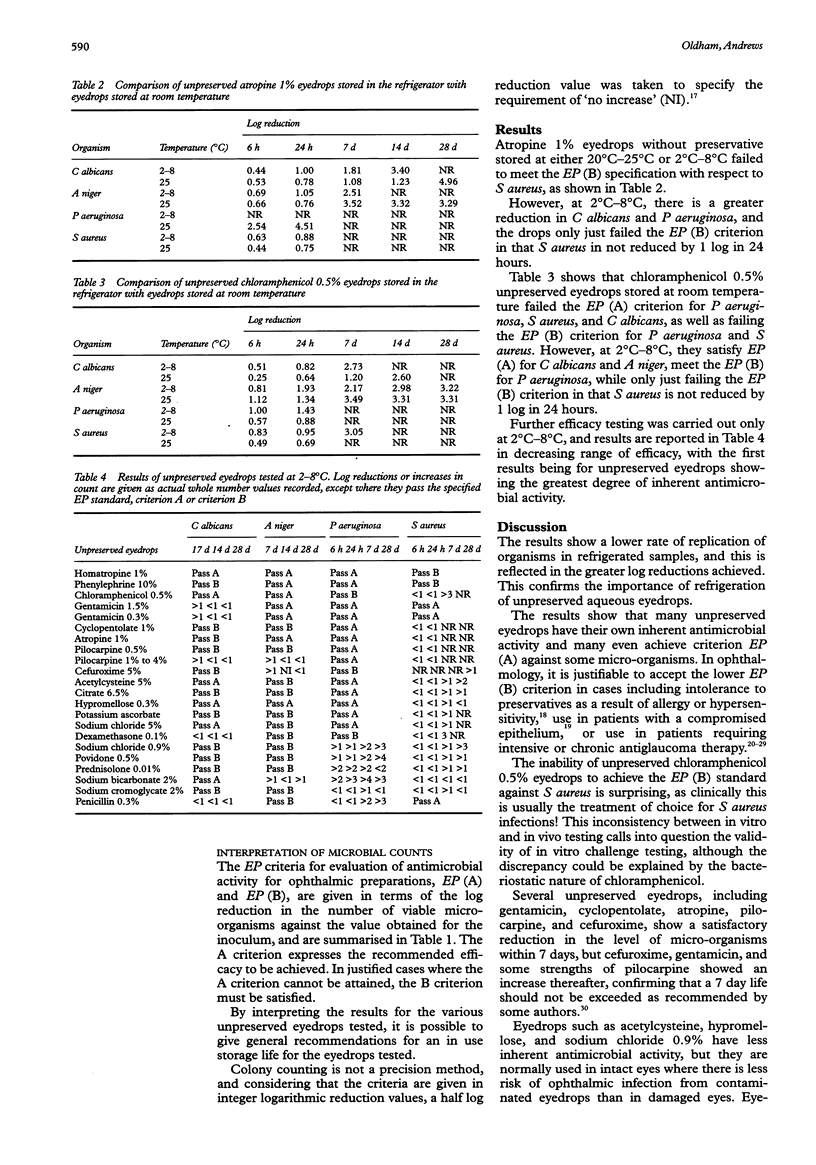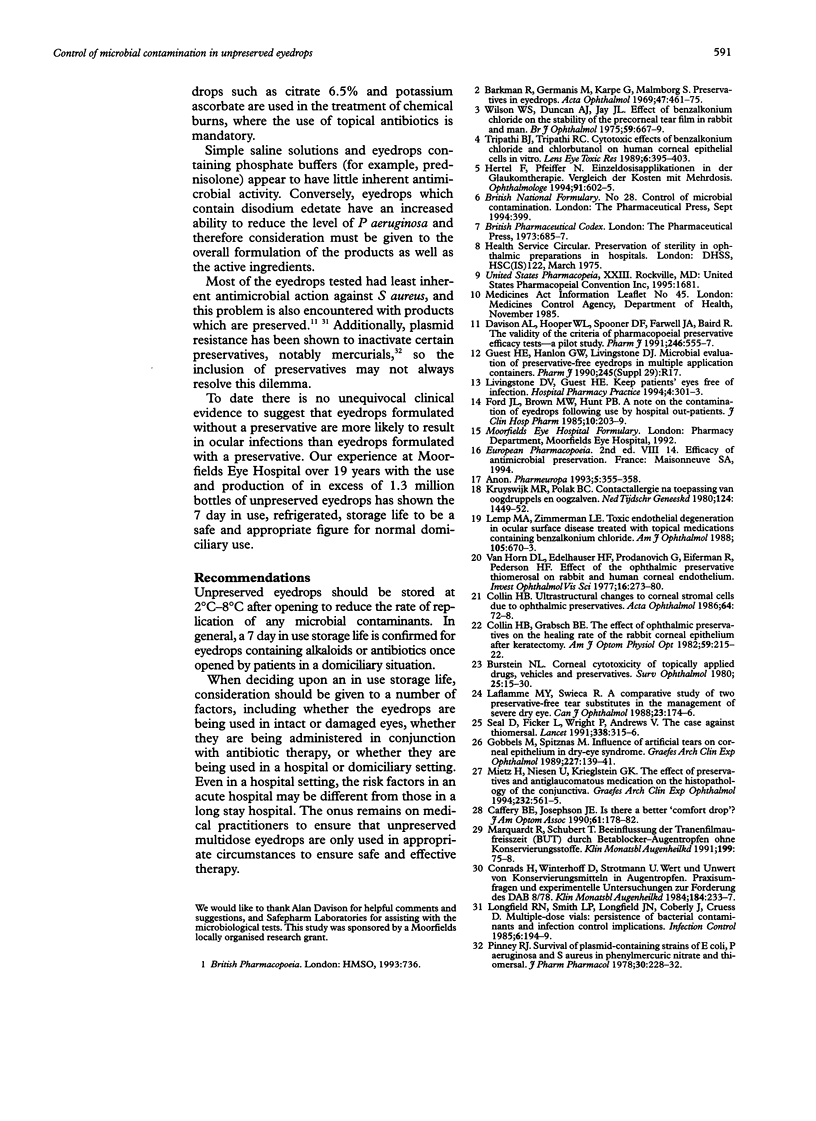Abstract
AIMS/BACKGROUND: Preservatives are added to multidose eyedrop containers to ensure that the eyedrops do not become heavily contaminated during patient use. This enables eyedrops to be used for up to 1 month after opening. However, patients are frequently required to use unpreserved eyedrops as their eyes are unable to tolerate these preservatives. Some commercial unpreserved unit dose eyedrops are available, but the range is limited, and they cannot be used in all cases. Twenty one different unpreserved eyedrop formulations in multidose bottles were tested to establish their inherent efficacy in antimicrobial preservation, and to help determine a suitable in use storage life. METHODS: The eyedrops were inoculated with a known quantity of four different micro-organisms according to the method of the European Pharmacopoeia 'Test for the efficacy of antimicrobial preservation'. After set periods of time, samples were taken to determine the number of viable organisms remaining. RESULTS: Antibiotics and alkaloids were generally shown to have higher kill rates than other eyedrops such as artificial tears and steroids. CONCLUSIONS: In general, once opened by individual patients in a domiciliary situation, a 7 day in use storage life is confirmed for eyedrops containing alkaloids or antibiotics, if they are stored in the refrigerator after opening.
Full text
PDF



Selected References
These references are in PubMed. This may not be the complete list of references from this article.
- Barkman R., Germanis M., Karpe G., Malmborg S. Preservatives in eye drops. Acta Ophthalmol (Copenh) 1969;47(3):461–475. doi: 10.1111/j.1755-3768.1969.tb08132.x. [DOI] [PubMed] [Google Scholar]
- Burstein N. L. Corneal cytotoxicity of topically applied drugs, vehicles and preservatives. Surv Ophthalmol. 1980 Jul-Aug;25(1):15–30. doi: 10.1016/0039-6257(80)90072-7. [DOI] [PubMed] [Google Scholar]
- Caffery B. E., Josephson J. E. Is there a better "comfort drop"? J Am Optom Assoc. 1990 Mar;61(3):178–182. [PubMed] [Google Scholar]
- Collin H. B., Grabsch B. E. The effect of ophthalmic preservatives on the healing rate of the rabbit corneal epithelium after keratectomy. Am J Optom Physiol Opt. 1982 Mar;59(3):215–222. doi: 10.1097/00006324-198203000-00003. [DOI] [PubMed] [Google Scholar]
- Collin H. B. Ultrastructural changes to corneal stromal cells due to ophthalmic preservatives. Acta Ophthalmol (Copenh) 1986 Feb;64(1):72–78. doi: 10.1111/j.1755-3768.1986.tb06875.x. [DOI] [PubMed] [Google Scholar]
- Conrads H., Winterhoff D., Strotmann U. Wert und Unwert von Konservierungsmitteln in Augentropfen. Praxisumfragen und experimentelle Untersuchungen zur Forderung des DAB 8/78. Klin Monbl Augenheilkd. 1984 Mar;184(3):233–237. doi: 10.1055/s-2008-1054453. [DOI] [PubMed] [Google Scholar]
- Ford J. L., Brown M. W., Hunt P. B. A note on the contamination of eye-drops following use by hospital out-patients. J Clin Hosp Pharm. 1985 Jun;10(2):203–209. doi: 10.1111/j.1365-2710.1985.tb01134.x. [DOI] [PubMed] [Google Scholar]
- Göbbels M., Spitznas M. Influence of artificial tears on corneal epithelium in dry-eye syndrome. Graefes Arch Clin Exp Ophthalmol. 1989;227(2):139–141. doi: 10.1007/BF02169786. [DOI] [PubMed] [Google Scholar]
- Hertel F., Pfeiffer N. Einzeldosisapplikationen in der Glaukomtherapie. Vergleich der Kosten mit Mehrdosis. Ophthalmologe. 1994 Oct;91(5):602–605. [PubMed] [Google Scholar]
- Kruyswijk M. R., Polak B. C. Contactallergie na toepassing van oogdruppels en oogzalven. Ned Tijdschr Geneeskd. 1980 Aug 30;124(35):1449–1452. [PubMed] [Google Scholar]
- Laflamme M. Y., Swieca R. A comparative study of two preservative-free tear substitutes in the management of severe dry eye. Can J Ophthalmol. 1988 Jun;23(4):174–176. [PubMed] [Google Scholar]
- Lemp M. A., Zimmerman L. E. Toxic endothelial degeneration in ocular surface disease treated with topical medications containing benzalkonium chloride. Am J Ophthalmol. 1988 Jun 15;105(6):670–673. doi: 10.1016/0002-9394(88)90062-1. [DOI] [PubMed] [Google Scholar]
- Longfield R. N., Smith L. P., Longfield J. N., Coberly J., Cruess D. Multiple-dose vials: persistence of bacterial contaminants and infection control implications. Infect Control. 1985 May;6(5):194–199. doi: 10.1017/s0195941700061415. [DOI] [PubMed] [Google Scholar]
- Mietz H., Niesen U., Krieglstein G. K. The effect of preservatives and antiglaucomatous medication on the histopathology of the conjunctiva. Graefes Arch Clin Exp Ophthalmol. 1994 Sep;232(9):561–565. doi: 10.1007/BF00182000. [DOI] [PubMed] [Google Scholar]
- Pinney R. J. Survival of plasmid-containing strains of Escherichia coli, Pseudomonas aeruginosa and Staphylococcus aureus in phenylmercuric nitrate and thiomersal. J Pharm Pharmacol. 1978 Apr;30(4):228–232. doi: 10.1111/j.2042-7158.1978.tb13210.x. [DOI] [PubMed] [Google Scholar]
- Seal D., Ficker L., Wright P., Andrews V. The case against thiomersal. Lancet. 1991 Aug 3;338(8762):315–316. doi: 10.1016/0140-6736(91)90455-x. [DOI] [PubMed] [Google Scholar]
- Tripathi B. J., Tripathi R. C. Cytotoxic effects of benzalkonium chloride and chlorobutanol on human corneal epithelial cells in vitro. Lens Eye Toxic Res. 1989;6(3):395–403. [PubMed] [Google Scholar]
- Van Horn D. L., Edelhauser H. F., Prodanovich G., Eiferman R., Pederson H. F. Effect of the ophthalmic preservative thimerosal on rabbit and human corneal endothelium. Invest Ophthalmol Vis Sci. 1977 Apr;16(4):273–280. [PubMed] [Google Scholar]
- Wilson W. S., Duncan A. J., Jay J. L. Effect of benzalkonium chloride on the stability of the precorneal tear film in rabbit and man. Br J Ophthalmol. 1975 Nov;59(11):667–669. doi: 10.1136/bjo.59.11.667. [DOI] [PMC free article] [PubMed] [Google Scholar]


